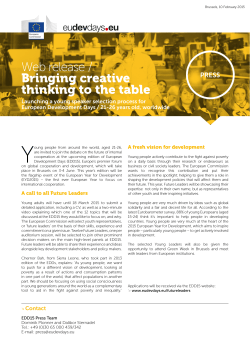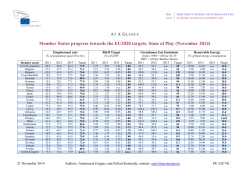
Tackling Poverty Through the Implementation of a Child
TACKLING POVERTY THROUGH THE IMPLEMENTATION OF A CHILD ALLOWANCE PROGRAM by Matthew Bruenig, Blogger Big Ideas 2015 - Pioneering Change: Innovative Ideas for Children and Families 31 No matter how you measure it, child poverty in the United States is extraordinarily common. According to the country’s official poverty metric, 21.8 percent of children—a total of 16 million kids—live below the poverty line. Under the Census Bureau’s supplemental poverty measurement, 22.3 percent of children are counted as impoverished. Under the relative poverty metric more commonly used elsewhere in the world, 21.2 percent of U.S. children are considered to be in poverty, which is one of the highest child poverty rates in the developed world. Children who grow up in these impoverished conditions face enormous challenges. Poverty undermines family and residential stability, contributes to nutritional problems, stunts physical and especially mental development, creates immense stress, and makes it difficult to excel in school. Children born in and around poverty have a very hard time moving up the economic ladder as adults, and those who do manage to do so still suffer lifelong health consequences nonetheless. For these reasons, it is crucial that we reduce poverty and material insecurity among families with children in this country. There are many ways to accomplish this goal, but the absolute best way is by implementing a child allowance program. Existing Child Benefit Programs Before getting into the specifics of what such a program would entail, it is useful to take account of some of our existing social programs for families with children. The two biggest programs come through the tax code via the child tax credit (CTC) and the personal tax exemption for children (PE). Although slightly different in form, these two policies suffer from identical problems: they both direct more money to middle- and upper-class families than to poor families, and they both deliver their benefits in largely unpredictable windfalls during tax season. The CTC is a complicated semi refundable tax credit program. Typically, a qualifying family is able to claim the CTC and reduce their federal income tax liability by $1,000 for each child. The availability of the benefit phases out after a certain income level, meaning upper-income families receive less than the full $1,000 benefit or, if their incomes are high enough, no benefit at all. Low-income families whose tax liabilities are less than the credit amount can sometimes receive a portion of the credit as part of their tax refund, but how much depends on their market earnings. So, although the typical middle-class family enjoys a $1,000 benefit from the CTC, poor and rich families receive less than that and sometimes no benefit at all. The PE is a relatively simple tax deduction program. It allows parents with dependent children to mark down their income for tax purposes by a set dollar amount for each child. In 2013, the PE amount was set at $3,900. The dollar value of the PE to a given family depends on their marginal tax rate. Those with the lowest incomes receive no dollar value from the PE. Families with incomes that put them in the 10 percent marginal tax rate receive $390 of value from the PE. Families in the 33 percent marginal tax rate get $1,287 of value. Overall, the richer the family is, the more value the PE is to them, up until their income is above the very high threshold, at which the PE phases out. If the goal of these programs is to help parents raise their children, they are terribly designed. Because the programs are attached to market incomes and tax liability, they provide relatively little assistance to poor families who need it the most. Due to complications and timing, the CTC and PE also make it nearly impossible to meaningfully incorporate their benefits into a stable household budget. For most, the benefits come as a relatively unknown windfall around April of each year, bundled together with any other tax refunds the family might also receive. Neither the benefit structure nor the annual windfall delivery system makes much sense. 32 Big Ideas 2015 - Pioneering Change: Innovative Ideas for Children and Families The Child Allowance A better way to approach this problem is to get rid of the CTC and PE in favor of a child allowance. Under a child allowance program, every family would receive a flat dollar amount for each child every month. Think of it like Social Security for kids. On first glance, this might seem like a radical idea, but it’s really not. A significant number of European countries already have child allowance programs in place, including France, Sweden, and Finland. The logistics of sending out checks to every family each month might seem like a daunting task, but the Social Security Administration (SSA) already sends out money to 63.5 million beneficiaries each month. Especially with modern benefit delivery systems, like direct deposit and reloadable debit cards, the SSA could easily be expanded to carry out this task. In addition to providing equal benefits for all children in a reliable monthly form, a child allowance could also deliver substantial childhood poverty reductions. I calculated that a $300 per month benefit level (a figure I chose because it matched Republican senator Mike Lee’s proposal to expand the CTC to $3,500) would pull 6.8 million children out of poverty and thereby cut the official child poverty rate by 42 percent. It would also pull 4.7 million parents out of poverty. Of course, it would not just help those 11.5 million people. Children and parents who remain in poverty, even with the child allowance, would still hugely benefit, as would those who are currently near poverty but not quite in it. In fact, all parents would benefit because all parents would receive it. A $300 per month child allowance would be costly, but not terribly so. In 2012, such benefits would have added up to $265 billion, but that’s not counting the savings that would come from eliminating the CTC and the PE. According to the Joint Committee on Taxation, the CTC costs around $57 billion each year. I cannot find any estimates of what the PE costs, but it’s bound to be well into the tens of billions of dollars as well. It’s plausible, therefore, that the net additional cost is actually somewhere near $165 billion. This is equal to about 1 percent of gross domestic product. Raising that amount of money is easily done as a policy matter, especially given that the United States has one of the lowest tax levels in the developed world. Other tax-expenditure programs could be trimmed, and rates could be bumped slightly. In addition, policymakers could set the benefit level lower than $300 if necessary. At any benefit level, it’s better to use a child allowance than the PE or CTC. Conclusion The sky-high child poverty rates we have in this country are almost solely a function of our inadequate social income policies. The way countries with low childhood poverty achieve their low levels is through income transfer programs just like or very similar to what I am proposing here. Labor markets do not provide parents with more income to undertake the enormous costs of bringing their children into adulthood. Thus, if parents are going to be assisted in that socially beneficial task, other distributive institutions are required, and the best such institution is the child allowance. Matthew Bruenig is a blogger who writes about politics, the economy, and political theory. He has also written for other publications, including The Atlantic, The New Republic, The American Prospect, and The Week. Big Ideas 2015 - Pioneering Change: Innovative Ideas for Children and Families 33
© Copyright 2025









